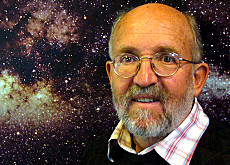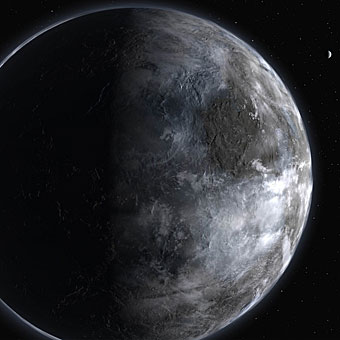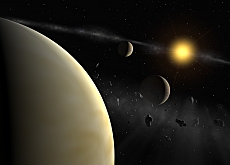Astrophysicists see the light

A team of Swiss and Finnish scientists have claimed the first direct observation of light reflected by a planet outside our solar system.
Although doubts have been raised about their measurement method, the development promises to lead to further discoveries as researchers rush to find an Earth-like planet in deep space.
In a recently published paper, Svetlana Berdyugina of the Federal Institute of Technology in Zurich and three colleagues announced they had detected light reflected by the atmosphere of planet HD189733b, which orbits a star in the Fox constellation in the Milky Way.
Planets are not luminous but reflect the light from the stars. Berdyugina and her colleagues exploited this property of light to track the planet throughout its orbit.
When light bounces off an object, it is polarised. It is possible to build filters which function much along the same lines as Polaroid sunglasses, allowing only this polarised light to pass through.
“This is a way of ‘switching off’ the star,” Berdyugina told swissinfo. “It is a very promising method, which we shall apply to planets that are already known, but which will also help us find new ones.”
The researchers were also able to infer the size of the planet’s atmosphere from their observations carried out using a telescope in the Canary Islands in the Atlantic Ocean.
The Zurich team discovered the presence of tiny particles of matter in the atmosphere of HD189733b which diffuse light and probably give the sky of this planet a pleasant blue colour. The same phenomenon makes our sky on Earth blue.
Berdyugina has declined to comment so far on the possible chemical composition of the atmosphere, although it has been suggested it might contain some water vapour.
Doubts
If the latest results are confirmed, they will represent an important breakthrough. But “if” is the operative word.
A leading specialist in polarised light, James Hough, head of astrophysical research at the University of Hertfordshire in Britain, describes Berdyugina’s result as “very surprising”.
“If it is correct, the planet must be very highly reflecting,” he told swissinfo. In the work that his team has carried out on similar types of planet, the upper limits for the polarisation are almost two orders of magnitude lower that those reported in the paper, he explained.
Nevertheless, the method used by the team is promising. Its application will open up the hunt for new planets of all sizes, including Earth-like worlds that have been the Holy Grail of astronomers since the first exoplanets were discovered by a team from the Geneva observatory.
Fourteen times larger than the Earth, and 380 times heavier, HD189733b itself is known as a “hot Jupiter” – a huge ball of gas orbiting close to its sun. Such planets are unwelcoming.
There is no solid surface and no known organism could withstand the pressure or the temperature. The atmosphere probably consists of poisonous gases, whipped up by fierce winds unheard of on Earth.
Cause for excitement
Despite all this, this exoplanet has delighted astrophysicists since its discovery by Swiss and French researchers in 2005.
It is relatively large, orbits a star only a little smaller than our sun, is fairly close to us (63 light years) and, most importantly, each of its transits can be observed from Earth.
In other words, scientists know whenever it passes in front of its star, which happens every 53 hours. Not that they can actually see it, even with the largest telescopes. What they observe is a decrease in the intensity of the light coming from the star.
In May 2007 an American team mapped its atmospheric temperature, using the Spitzer infrared telescope – the first map of any extrasolar planet.
swissinfo, based on an article in French by Marc-André Miserez
Exoplanets are planets outside our solar system.
The first exoplanet was discovered by Swiss astronomers Michel Mayor and Didier Queloz from the Geneva Observatory in 1995.
By the beginning of 2008, more than 270 possible exoplanets had been identified, although none can be seen by telescope. They can only be detected indirectly.
The overwhelming majority of exoplanets found so far are so-called “hot Jupiters”: large gas planets orbiting close to their star.
However, with other methods of detection astrophysicists expect to find many solid, Earth-like planets, which could harbour life.

In compliance with the JTI standards
More: SWI swissinfo.ch certified by the Journalism Trust Initiative












You can find an overview of ongoing debates with our journalists here . Please join us!
If you want to start a conversation about a topic raised in this article or want to report factual errors, email us at english@swissinfo.ch.